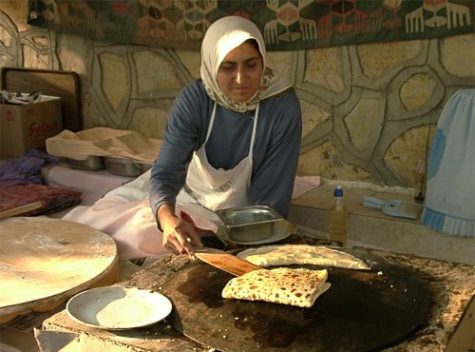Monthly Archives: June 2019
Seven Sleepers’ Day (Siebenschläfertag) on June 27 is a feast day commemorating the legend of the Seven Sleepers as well as one of the best-known bits of traditional weather lore (expressed as a proverb) remaining in German-speaking Europe.
The atmospheric conditions on that day are supposed to determine or predict the average summer weather of the next seven weeks. and it is believed that whatever the weather is on this day, it will remain so for seven weeks.
Apparently this forecast is about as accurate as Groundhog Day forecasts in the U.S. The story of the Seven Sleepers has many versions and is widespread throughout the Christian and Muslim worlds. It has been told and retold repeatedly from ancient times to the present day.
The Story of the Seven Sleepers
The earliest Syriac version of the tale states that during the persecutions of the Roman emperor Decius, around 250, seven young men were accused of being Christians. They were given some time to recant their faith, but chose instead to give their worldly goods to the poor and retire to a mountain cave to pray, where they fell asleep.
The emperor, seeing that their attitude towards their faith had not changed, ordered the mouth of the cave to be sealed. Decius died in 251, and many years passed during which Christianity went from being persecuted to being the state religion of the Roman Empire. At some later time—usually given as during the reign of Theodosius II (408–450)—the landowner decided to open up the sealed mouth of the cave, thinking to use it as a cattle pen. He opened it and found the sleepers inside.
They awoke, imagining that they had slept for a single day, and sent one of their number to Ephesus to buy food, with instructions to be careful in case the Romans were to recognize him and seize him. Upon arriving in the city, this youth was astounded to find buildings with crosses attached. The townspeople for their part were amazed to find a man trying to spend old coins from the reign of Decius. The bishop was summoned to interview the sleepers; they told him their miracle story, and died praising God.
As the earliest versions of the legend spread from Ephesus, an early Christian catacomb came to be associated with it, attracting scores of pilgrims. On the slopes of Mount Pion near Ephesus, the cave of the Seven Sleepers with ruins of the church built over it was excavated in 1927–28. The excavation brought to light several hundred graves which were dated to the 5th and 6th centuries. Inscriptions dedicated to the Seven Sleepers were found on the walls of the church and in the graves. This cave is now a local tourist attraction.
The story of the Seven Sleepers is probably best known in the Muslim world. It is told in the Qur’an (Surah 18, verse 9-26). The Qur’anic rendering of this story doesn’t state exactly the number of sleepers; the exact number is believed to be known to God alone. It also gives the number of years that they slept as 300 solar years (equivalent to 309 lunar years).
Unlike the Christian story, the Islamic version includes mention of a dog who accompanied the youths into the cave, and was also asleep. But when people passed by the cave it looked as if the dog was just keeping watch at the entrance, making them afraid of seeing what is in the cave once they saw the dog. In Islam, these youths are referred to as “The People of the Cave.”
There are numerous retellings of the tale in early modern and modern literature. John Donne’s (1572-1631) poem “The good-morrow” contains the lines:
were we not wean’d till then?
But suck’d on country pleasures, childishly?
Or snorted we in the Seven Sleepers’ den?”
A Recipe For Today
Given that the sleepers were hungry when they awoke and sent one of their number to buy food, I thought a local Turkish recipe found at roadside food stalls would be suitable for the day. Gözleme are flaky pastry packets stuffed with a mix of feta cheese and spinach plus herbs and spices. Variants can be found throughout Turkey and Greece. They can also be stuffed with ground lamb flavored with garlic, paprika, and cumin. Once in a while you will come across them with both fillings in one.
Ingredients:
Dough
- 2 cups (250 g) plain flour, unbleached
- 2 cups (250 g) wholemeal flour
- pinch of salt
- vegetable oil
Filling
- 2 cups (450 g) grated feta cheese or
- 2 cups (200 g) finely chopped spinach leaves
- ½ cup (50 g) chopped fresh mint leaves
- ½ cup (50 g)chopped flat leaf parsley
- ½ cup (80 g) chopped green onion
- ½ cup (80 g) diced white onion
- 1 tsp (5 g) white pepper
- 1 tsp (5 g) allspice
- 1 tsp (5 g) dried oregano
- 1 tsp (5 g) dried sage
Instructions:
Sift the flours and salt and mix with 1 ½ cups (210 ml) of water in an electric mixer with a dough hook or knead by hand for at least ten minutes.
Keep adding more water a little at a time until you get a very pliable, elastic dough that is easy to knead, but not so watery that it is too sticky to handle. Dust frequently with the extra flour.
Allow the dough to stand, covered, overnight (at least 10 hours). When ready to cook, divide the dough into six round portions. Dust with flour. Roll one of the rounds flat with a rolling pin on a flour-dusted surface, into a rectangle shape, as thinly as possible.
Brush on a little oil, then fold over into a square. Fold over twice more into a square. Repeat the dusting, rolling out to a large rectangle, folding, oiling, dusting process three more times. Repeat the entire process for each of the six rounds
Take one of the folded dough squares and roll it out very thinly for the final time, into a large square. Sprinkle on the filling sparingly – – as you would for a pizza topping but on half of the square only.
Start with a layer of cheese. Mix the spinach, mint, green onion and parsley together in a bowl, and add some of this as the next layer. Mix together the white onion, spices, and dried herbs, and add some as a final topping.
Fold over the uncovered half of the square to cover the filling. Press down lightly all over.
Cook on a pre-heated oiled heavy skillet (cast iron if possible). Make sure the skillet is not too hot. It takes about 10 minutes to cook everything through. Turn them often until the outside is golden and crisp. Cut into smaller squares and serve with lemon wedges. Yield 6.
Some Weather Science
The Seven Sleepers singularity is contested as quite inaccurate in practice. Objections have been raised that the weather lore associated with the day might have arisen before the 1582 Gregorian calendar reform, and as at this time the difference to the Julian calendar amounted to ten days, July 7 would be the actual Seven Sleepers Day. Based on this date the prediction has a slightly increased probability of about 55–70%, if confined to the southern parts of Germany, where the rule seems to have originated. In contrast, the weather lore is not applicable to Northern Germany and its rather oceanic climate.
Depending on the meandering flow of the polar jet stream in the Northern Hemisphere (Rossby waves) and the emergence of veering low-pressure and high-pressure (anticyclone) systems, the atmospheric conditions tend to stabilize in early July: either a high-pressure ridge takes hold over Scandinavia, which may coalesce with the subtropical Azores High to form a stable and warm macro weather situation; or a high North Atlantic oscillation between the Icelandic Low and the Azores High implies a long-standing influx of wet air masses into Central Europe.
Sources:
The 11th of June is known as the Holiday of the Happy Gnomes.
Gnomes are Earth Spirits or Earth Elementals. Paracelsus describes them as being two spans high, reluctant to interact with humanity and able to pass through the Earth as easily as we walk through the air.
They might be ‘reluctant’ because they are lovers of shiny things and guardians of all gemstones, ores and minerals found in the earth – and also treasures which humans have buried in the earth.
Gnomes live in underground caves, so when humans began digging cellars for their homes, these were very attractive to Gnomes. Cellars are where we keep beer, wine and cheese all things which Gnomes soon grew very fond of. But as they like to pay for whatever they might take, if you have a gnome in your beer cellar, you will also be blessed with the best beer in the district.
You can attract a Gnome to your cellar, or thank the spirits that live there, by leaving them out the occasional glass of beer or wine and a nice cheese sandwich. Thus ensuring your spirits continue to be Happy Gnomes.
- Found at Raven Corvus
- Read more about Gnomes here: Garden Gnomes and Elemental Spirits
The 2nd of June is St Erasmus of Formia’s day – better known as St Elmo. He is said to have kept preaching during a thunderstorm and even when lightning struck near him. Sailors therefore look on the electrical discharges that hit masts or other protuberances as a sign that the saint is watching over them, and call this St Elmo’s Fire.
St. Elmo’s fire is a bright blue or violet glow, appearing like fire in some circumstances, from tall, sharply pointed structures such as lightning rods, masts, spires and chimneys, and on aircraft wings or nose cones. St. Elmo’s fire can also appear on leaves and grass, and even at the tips of cattle horns. Often accompanying the glow is a distinct hissing or buzzing sound. It is sometimes confused with ball lightning.
Invoking Saint Erasmus
In addition to being the patron saint of sailors, Saint Erasmus is also the patron saint of a host of other groups, including explosives workers, ordnance workers, and women in labor. He is also invoked against colic, birth pains, intestinal disorders, stomach diseases, and storms. He is one of the Fourteen Holy Helpers, a group of saints regarded as special protectors against various illnesses.
Invocation of St. Erasmus
Holy martyr Erasmus, who didst willingly and bravely bear the trials and sufferings of life, and by thy charity didst console many fellow-sufferers; I implore thee to remember me in my needs and to intercede for me with God. Staunch confessor of the Faith, victorious vanquisher of all tortures, pray Jesus for me and ask Him to grant me the grace to live and die in the Faith through which thou didst obtain the crown of glory. Amen.
Account of His Life and Martyrdom
Erasmus was Bishop of Formia, Italy. During the persecution against Christians under the emperors Diocletian (284-305) and Maximian Hercules (284-305), he left his diocese and went to Mount Libanus, where he hid for seven years. However, an angel is said to have appeared to him, and counseled him to return to his city.
On the way, he encountered some soldiers who questioned him. Erasmus admitted that he was a Christian and they brought him to trial at Antioch before the emperor Diocletian. After suffering terrible tortures, he was bound with chains and thrown into prison, but an angel appeared and helped him escape.
He passed through Lycia, where he raised up the son of an illustrious citizen. This resulted in a number of baptisms, which drew the attention of the Western Roman Emperor Maximian who, according to Voragine, was “much worse than was Diocletian.” Maximian ordered his arrest and Erasmus continued to confess his faith. They forced him to go to a temple of the idol, but along the saint’s route all the idols fell and were destroyed, and from the temple there came fire which fell upon many of the pagans.
That made the emperor so angry he had Erasmus enclosed in a barrel full of protruding spikes, and the barrel was rolled down a hill. But an angel healed him. Further tortures ensued.
When he was recaptured, he was brought before the emperor and beaten and whipped, then coated with pitch and set alight (as Christians had been in Nero’s games), and still he survived. Thrown into prison with the intention of letting him die of starvation, St Erasmus managed to escape.
He was recaptured and tortured some more in the Roman province of Illyricum, after boldly preaching and converting numerous pagans to Christianity. Finally, according to this version of his death, his stomach was slit open and his intestines wound around a windlass. This version may have developed from interpreting an icon that showed him with a windlass, signifying his patronage of sailors.
Sources:
According to astrological and lunar lore, there are best days for doing a variety of tasks. The best days listed here are based on both the phase of the moon and its position in the zodiac. Many people believe that if you do the tasks on the dates listed, you will get the best results possible.
June 1:
- Advertise Something for Sale
- Ask For a Loan
- Dig Post Holes
- Get Married
- Make Jams and Jellies
- Mow Grass (to slow growth)
- Paint
- Plant Root Crops
- Transplant (seedlings and plants)
June 2:
- Cut Hair (to slow growth)
- Harvest
- Kill Plant Pests
- Mow Grass (to slow growth)
- Quit Smoking
- Wash Wooden Floors
June 3:
- Cut Firewood
- Dig Holes
- Kill Plant Pests
- Mow Grass (to increase growth)
- Travel (for pleasure)
June 4:
- Bake
- Buy a Home
- Cut Firewood
- Cut Hair (to increase growth)
- Dig Holes
- Get Married
- Mow Grass (to increase growth)
- Plant Above Ground Crops
- Plant Flowers
- Plant Seed Beds
- Start Diet (to gain weight)
- Wax Floors Wax Floors
June 5:
- Bake
- Buy a Home
- Cut Firewood
- Cut Hair (to increase growth)
- Dig Holes
- Get Married
- Mow Grass (to increase growth)
- Plant Above Ground Crops
- Plant Flowers
- Plant Seed Beds
- Start Diet (to gain weight)
- Wax Floors Wax Floors
June 6:
- Buy a Home
- Cut Firewood
- Dig Holes
- Get Married
- Kill Plant Pests
- Mow Grass (to increase growth)
- Paint
- Travel (for pleasure)
June 7:
- Buy a Home
- Cut Firewood
- Dig Holes
- Get Married
- Kill Plant Pests
- Mow Grass (to increase growth)
- Paint
- Travel (for pleasure)
June 8:
- Cut Firewood
- Dig Holes
- Kill Plant Pests
- Mow Grass (to increase growth)
- Wax Floors Wax Floors
June 9:
- Cut Firewood
- Dig Holes
- Kill Plant Pests
- Mow Grass (to increase growth)
- Wax Floors Wax Floors
June 10:
- Bake
- Cut Firewood
- Dig Holes
- Get Married
- Mow Grass (to increase growth)
- Plant Above Ground Crops
- Plant Flowers
- Wax Floors Wax Floors
June 11:
- Bake
- Cut Firewood
- Dig Holes
- Get Married
- Mow Grass (to increase growth)
- Plant Above Ground Crops
- Plant Flowers
- Set Eggs
- Wax Floors Wax Floors
June 12:
- Bake
- Cut Firewood
- Dig Holes
- Get Married
- Mow Grass (to increase growth)
- Plant Above Ground Crops
- Plant Flowers
- Set Eggs
- Wax Floors
June 13:
- Cut Firewood
- Cut Hair (to increase growth)
- Dig Holes
- Mow Grass (to increase growth)
- Plant Above Ground Crops
- Plant Seed Beds
- Wax Floors
June 14:
- Cut Firewood
- Cut Hair (to increase growth)
- Dig Holes
- Mow Grass (to increase growth)
- Plant Above Ground Crops
- Plant Seed Beds
- Wax Floors
June 15:
- Advertise Something for Sale
- Castrate Farm Animals
- Cut Firewood
- Dig Holes
- Kill Plant Pests
- Mow Grass (to increase growth)
- Potty Train a Child
- Travel (for pleasure)
- Wash Windows
- Wean a Baby or an Animal
June 16:
- Advertise Something for Sale
- Castrate Farm Animals
- Cut Firewood
- Dig Holes
- Kill Plant Pests
- Mow Grass (to increase growth)
- Potty Train a Child
- Travel (for pleasure)
- Wash Windows
- Wean a Baby or an Animal
June 17:
- Castrate Farm Animals
- Mow Grass (to slow growth)
- Plant Root Crops
- Potty Train a Child
- Prune Trees
- Slaughter
- Wean a Baby or an Animal
June 18:
- Castrate Farm Animals
- Mow Grass (to slow growth)
- Plant Root Crops
- Potty Train a Child
- Prune Trees
- Slaughter:
- Wean a Baby or an Animal
June 19:
- Castrate Farm Animals
- Cut Hair (to slow growth)
- Dig Post Holes
- Kill Plant Pests
- Make Jams and Jellies
- Mow Grass (to slow growth)
- Paint
- Potty Train a Child
- Quit Smoking
- Slaughter
- Start Diet (to lose weight)
- Wash Wooden Floors
- Wean a Baby or an Animal
June 20:
- Castrate Farm Animals
- Cut Hair (to slow growth)
- Dig Post Holes
- Kill Plant Pests
- Make Jams and Jellies
- Mow Grass (to slow growth)
- Paint
- Potty Train a Child
- Quit Smoking
- Set Eggs
- Start Diet (to lose weight)
- Wash Wooden Floors
- Wean a Baby or an Animal
June 21:
- Castrate Farm Animals
- Cut Hair (to slow growth)
- Dig Post Holes
- Kill Plant Pests
- Make Jams and Jellies
- Mow Grass (to slow growth)
- Paint
- Potty Train a Child
- Quit Smoking
- Set Eggs
- Start Diet (to lose weight)
- Wash Wooden Floors
- Wean a Baby or an Animal
June 22:
- Brew
- Can Fruits and Vegetables
- Castrate Farm Animals
- Hunting
- Mow Grass (to slow growth)
- Plant Root Crops
- Potty Train a Child
- Transplant (seedlings and plants)
- Wean a Baby or an Animal
June 23:
- Brew
- Can Fruits and Vegetables
- Castrate Farm Animals
- Hunting
- Mow Grass (to slow growth)
- Plant Root Crops
- Potty Train a Child
- Transplant (seedlings and plants)
- Wean a Baby or an Animal
June 24:
- Cut Hair (to slow growth)
- Demolition
- Dry Fruits and Vegetables
- Kill Plant Pests
- Mow Grass (to slow growth)
- Pick Apples and Pears
- Quit Smoking
- Start Diet (to lose weight)
- Wash Wooden Floors
June 25:
- Cut Hair (to slow growth)
- Demolition
- Harvest
- Kill Plant Pests
- Mow Grass (to slow growth)
- Pick Apples and Pears
- Quit Smoking
- Start Diet (to lose weight)
- Wash Wooden Floors
June 26:
- Cut Hair (to slow growth)
- Demolition
- Harvest
- Kill Plant Pests
- Mow Grass (to slow growth)
- Pick Apples and Pears
- Quit Smoking
- Start Diet (to lose weight)
- Wash Wooden Floors
June 27:
- Advertise Something for Sale
- Ask For a Loan
- Dig Post Holes
- Get Married
- Make Jams and Jellies
- Mow Grass (to slow growth)
- Paint
- Plant Root Crops
- Transplant (seedlings and plants)
June 28:
- Advertise Something for Sale
- Ask For a Loan
- Dig Post Holes
- Get Married
- Make Jams and Jellies
- Mow Grass (to slow growth)
- Paint
- Plant Root Crops
- Transplant (seedlings and plants)
June 29:
- Cut Hair (to slow growth)
- Harvest
- Kill Plant Pests
- Mow Grass (to slow growth)
- Quit Smoking
- Wash Wooden Floors
June 30:
- Cut Hair (to slow growth)
- Harvest
- Kill Plant Pests
- Mow Grass (to slow growth)
- Quit Smoking
- Wash Wooden Floors
Source: The Farmer’s Almanac













